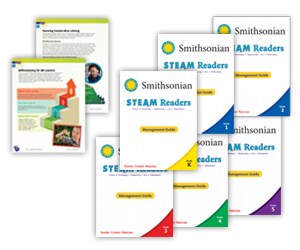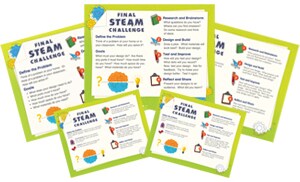
Created in collaboration with the Smithsonian Institution, this dynamic series engages students with high-interest readers that explore how science, technology, engineering, art, and math are used to solve real-world problems.
With Smithsonian STEAM Readers, students will:
- Develop their communication, collaboration, critical thinking, and creativity skills
- Explore the engineering design process and discover engineering innovations
- Learn about STEAM careers
- Engage in STEAM challenges that are ideal for makerspaces and project-based learning

Download our grades 1-6 correlation document for the Nonfiction readers, Science readers, and STEAM Readers series.
Download our grades 1-6 Ontario correlation document!
Explore digital access in the Spark Reading Digital Library. Sign up for a free 30 day trial today!
A message from the Sally Creel, Series Editor…
Our youngest learners come into our classrooms full of wonder and curiosity. As educators, it is our job to nurture that creativity and celebrate the wonder. It is often the simplest ideas that bring about the deepest learning.
Take, for example, a group of three fourth-grade girls who developed a carboard prototype of a colour-changing tire. When I interviewed the group, they explained that many people find it difficult to know when to replace their tires. It’s a problem that usually isn’t at the forefront of most people’s minds. They recognized that driving on worn tires is extremely dangerous. So, they were inspired to create a tire that would provide clear warning signs. They explained that as their tire is used, small amounts of tire are worn away. The black rubber on the outside of the tire gradually wears to green, then yellow, and finally to red to let the driver know it is no longer safe. Such a simple idea, right? Why has no one thought of it before? These fourth graders were unfettered with limitations born of societal influence, such as traditional gender stereotypes regarding interest or notions of what is possible.
The goal of Smithsonian STEAM Readers is to help young readers see the potential for innovation in the world around them. Throughout the series, students read countless examples of failure and perseverance that ultimately led to successful designs and innovations. Students develop an appreciation for the power of perseverance, coupled with curiosity and creativity. Then, they experience it firsthand as they engage in engineering design challenges related to the books. Students are able to see what is possible when they persevere.
This opportunity to design, fail, redesign, and improve helps learners build a set of invaluable life skills. It is so exciting to see students developing and refining these skills over time. These young students will be the people who change the world as we know it. It is our job to provide them with the skills to do so!
















